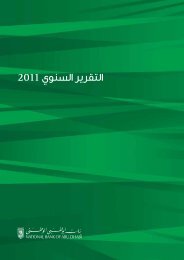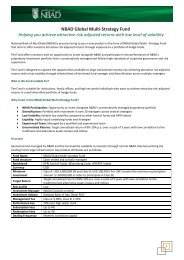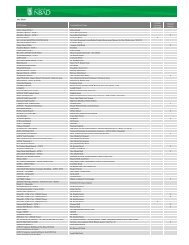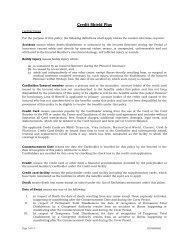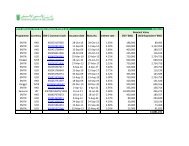English Version - National Bank of Abu Dhabi
English Version - National Bank of Abu Dhabi
English Version - National Bank of Abu Dhabi
Create successful ePaper yourself
Turn your PDF publications into a flip-book with our unique Google optimized e-Paper software.
Notes to the consolidated financial statements<br />
Notes to the consolidated financial statements<br />
3 Significant accounting policies (continued) 3 Significant accounting policies (continued)<br />
(vi) Offsetting<br />
Financial assets and liabilities are set <strong>of</strong>f and the net<br />
amount presented in the statement <strong>of</strong> financial position<br />
when, and only when, the Group has a legal right to<br />
set <strong>of</strong>f the amounts and intend either to settle on a<br />
net basis, or to realise the asset and settle the liability<br />
simultaneously.<br />
(vii) Amortised cost measurement<br />
The amortised cost <strong>of</strong> a financial asset or liability is<br />
the amount at which the financial asset or liability<br />
is measured at initial recognition, minus principal<br />
repayments, plus or minus the cumulative amortisation<br />
using the effective interest method <strong>of</strong> any difference<br />
between the initial amount recognised and the maturity<br />
amount, minus any reduction for impairment.<br />
(viii) Fair value measurement<br />
The determination <strong>of</strong> fair values <strong>of</strong> financial assets and<br />
liabilities is based on quoted market prices or dealer<br />
quotations for financial instruments traded in active<br />
markets. A market is regarded as active if quoted prices<br />
are readily and regularly available and represent actual<br />
and regularly occurring market transactions on an arm’s<br />
length basis. Quoted bid prices are used for financial<br />
assets and quoted ask prices are used for financial<br />
liabilities.<br />
For financial instruments not traded on an active market,<br />
fair value is determined based on recent transactions,<br />
brokers’ quotes or a widely recognised valuation<br />
technique.<br />
Valuation techniques include using recent arm’s length<br />
transactions between knowledgeable, willing parties (if<br />
available), reference to the current fair value <strong>of</strong> other<br />
instruments that are substantially the same, discounted<br />
cash flow analyses and option pricing models. The<br />
chosen valuation technique makes maximum use <strong>of</strong><br />
market inputs, relies as little as possible on estimates<br />
specific to the Group, incorporates all factors that market<br />
participants would consider in setting a price, and is<br />
consistent with accepted economic methodologies<br />
for pricing financial instruments. Inputs to valuation<br />
techniques reasonably represent market expectations<br />
and measures <strong>of</strong> the risk-return factors inherent in the<br />
financial instrument.<br />
The best evidence <strong>of</strong> the fair value <strong>of</strong> a financial<br />
instrument at initial recognition is the transaction<br />
price, i.e., the fair value <strong>of</strong> the consideration given<br />
or received, unless the fair value <strong>of</strong> that instrument is<br />
evidenced by comparison with other observable current<br />
market transactions in the same instrument (i.e., without<br />
modification or repackaging) or based on a valuation<br />
technique whose variables include only data from<br />
observable markets.<br />
(ix) Identification and measurement <strong>of</strong> impairment<br />
An assessment is made at each reporting date and<br />
periodically during the year to determine whether<br />
there is any objective evidence that financial assets not<br />
carried at fair value through pr<strong>of</strong>it or loss, are impaired.<br />
Financial assets are impaired when objective evidence<br />
indicates that a loss event has occurred after the initial<br />
recognition <strong>of</strong> the asset and that the loss event has an<br />
impact on the future cash flows <strong>of</strong> the asset that can be<br />
estimated reliably.<br />
Objective evidence that financial assets (including<br />
equity securities) are impaired can include significant<br />
financial difficulty <strong>of</strong> the borrower or issuer, default or<br />
delinquency by a borrower, restructuring <strong>of</strong> a loan or<br />
advance by the Group on terms that the Group would<br />
not otherwise consider, indications that a borrower or<br />
issuer will enter bankruptcy, the disappearance <strong>of</strong> an<br />
active market for a security, or other observable data<br />
relating to a group <strong>of</strong> assets such as adverse changes in<br />
the payment status <strong>of</strong> borrowers or issuers in the group,<br />
or economic conditions that correlate with defaults in<br />
the group. In addition, for an investment in an equity<br />
security, a significant or prolonged decline in its fair<br />
value below its cost is objective evidence <strong>of</strong> impairment.<br />
The Group considers evidence <strong>of</strong> impairment at both<br />
a specific asset and collective level. All individually<br />
significant assets are assessed for specific impairment.<br />
All individually significant assets found not to be<br />
specifically impaired are then collectively assessed<br />
for any impairment that has been incurred but not yet<br />
identified. Assets that are not individually significant<br />
are collectively assessed for impairment by grouping<br />
together financial assets with similar risk characteristics.<br />
In assessing collective impairment the Group uses<br />
statistical modelling <strong>of</strong> historical trends <strong>of</strong> the probability<br />
<strong>of</strong> default, timing <strong>of</strong> recoveries and the amount <strong>of</strong> loss<br />
incurred, adjusted for management’s judgement as to<br />
whether current economic and credit conditions are<br />
such that the actual losses are likely to be greater or less<br />
than suggested by historical modelling. Default rates,<br />
loss rates and the expected timing <strong>of</strong> future recoveries<br />
are regularly benchmarked against actual outcomes to<br />
ensure that they remain appropriate.<br />
Impairment losses on financial assets carried at amortised<br />
cost are measured as the difference between the carrying<br />
amount <strong>of</strong> the financial asset and the present value <strong>of</strong><br />
estimated cash flows discounted at the original effective<br />
interest rate. Impairment losses are recognised in the<br />
consolidated income statement and reflected in an<br />
allowance account against such financial assets. When<br />
a subsequent event causes the amount <strong>of</strong> impairment<br />
loss to decrease, the decrease in impairment loss is<br />
reversed through the consolidated income statement.<br />
Impairment losses on available for sale investment<br />
securities are recognised by transferring the difference<br />
between the amortised acquisition cost and current<br />
fair value out <strong>of</strong> other comprehensive income to the<br />
consolidated income statement. When a subsequent<br />
event causes the amount <strong>of</strong> impairment loss on availablefor-sale<br />
debt security to decrease, the impairment loss is<br />
reversed through the consolidated income statement.<br />
Impairment losses on an unquoted equity instrument that<br />
is carried at cost because its fair value cannot be reliably<br />
measured, is measured as the difference between the<br />
carrying amount <strong>of</strong> the financial asset and the present<br />
value <strong>of</strong> estimated future cash flows discounted at the<br />
current market rate <strong>of</strong> return for a similar financial asset.<br />
Such impairment losses shall not be reversed.<br />
(c) Cash and cash equivalents<br />
For the purpose <strong>of</strong> consolidated statement <strong>of</strong> cash flows,<br />
cash and cash equivalents comprise cash, balances<br />
with central banks and due from banks with original<br />
maturities <strong>of</strong> less than three months, which are subject<br />
to insignificant risk <strong>of</strong> changes in fair value, and are<br />
used by the Group in the management <strong>of</strong> its short-term<br />
commitments.<br />
Cash and cash equivalents are carried at amortised cost<br />
in the statement <strong>of</strong> financial position.<br />
(d) Investments at fair value through pr<strong>of</strong>it or loss<br />
These are financial assets classified as held for trading<br />
or designated as such upon initial recognition. These<br />
are initially recognised and subsequently measured at<br />
fair value with transaction costs taken directly to the<br />
consolidated income statement. All related realised and<br />
unrealised gains or losses are included in net investment<br />
income.<br />
(e) Due from banks<br />
These are stated at amortised cost, less any allowance<br />
for impairment.<br />
(f) Loans and advances<br />
Loans and advances are non-derivative financial assets<br />
with fixed or determinable payments that are not quoted<br />
in an active market and that the Group does not intend<br />
to sell immediately or in the near term.<br />
These are initially measured at fair value (being<br />
the transaction price at inception) plus incremental<br />
direct transaction costs and subsequently measured<br />
at amortised cost using the effective interest method,<br />
adjusted for effective fair value hedges, net <strong>of</strong> interest<br />
suspended and provisions for impairment.<br />
(g) Islamic financing and investing contracts<br />
i) Definitions<br />
Ijara<br />
Ijara consists <strong>of</strong> Ijara muntahia bitamleek.<br />
Ijara muntahia bitamleek is an agreement whereby<br />
the Group (the lessor) conveys to the customer (the<br />
lessee), in return for a specific rent, the right to use a<br />
specific asset for a specific period <strong>of</strong> time, against<br />
payment <strong>of</strong> fixed periodical and variable rental. Under<br />
this agreement, the Group purchases or constructs the<br />
asset and rents it to the customer. The contract specifies<br />
the leasing party and the amount and timing <strong>of</strong> rental<br />
payments and responsibilities <strong>of</strong> both parties during the<br />
term <strong>of</strong> the lease. The customer provides the Group with<br />
an undertaking to settle the rental amount as per the<br />
agreed schedule.<br />
The Group retains the ownership <strong>of</strong> the assets throughout<br />
the entire lease term. At the end <strong>of</strong> the lease term, the<br />
Group sells the leased asset to the customer at a nominal<br />
value based on a sale undertaking by the Group.<br />
Murabaha<br />
An agreement whereby the Group sells to a customer<br />
49




